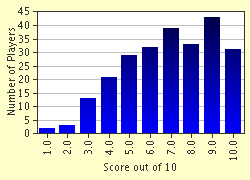Quiz Answer Key and Fun Facts
1. The Monty Python fellows apparently loved motifs, and played with them throughout the series. In the first episode, one motif revolved around characters sitting on which of these defenseless, yet delicious, animals?
2. Wolfgang Amadeus Mozart introduces the first sketch of the episode, 'Famous Deaths'. Whose death are we not privileged to witness during this scene?
3. The second scene of the first episode is the excellent Italian language class sketch, featuring the barely literate (in Italian) Terry Jones as the instructor of a group of fluent Italian pupils. The instructor reviews last week's course, in which the Italian word for which of these was central?
4. A short set of Terry Gilliam's animations follows the Italian class sketch. The animated sequence turns out to be an advertisement for which brand of butter?
5. Following the Gilliam animations we have an episode of 'It's the Arts'. First up is an interview of a world-renowned film director, Sir Edward Ross. The interviewer (played by John Cleese) attempts to address the distinguished director with all but which of the following?
6. Following the Ross interview, we are treated to another interview, conducted by Eric Idle, of the composer Arthur Jackson. What is Mr. Jackson's rather unfortunate nickname?
7. The final segment of 'It's the Arts' is a bicycle race, this one involving artists who paint while riding. Which artist is especially covered during the race?
8. Which member of Monty Python calls the bicycle race in a rather energetic fashion from the Tolworth Roundabout at the A-3 as Sam Trench?
9. The final sketch in the first episode is the 'world's funniest joke' sketch, a Monty Python classic. Who was the original author of the world's funniest (and most lethal) joke?
10. Do we ever hear the English translation of the world's funniest joke during this episode?
Source: Author
thejazzkickazz
This quiz was reviewed by FunTrivia editor
ladymacb29 before going online.
Any errors found in FunTrivia content are routinely corrected through our feedback system.

